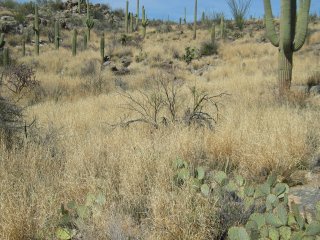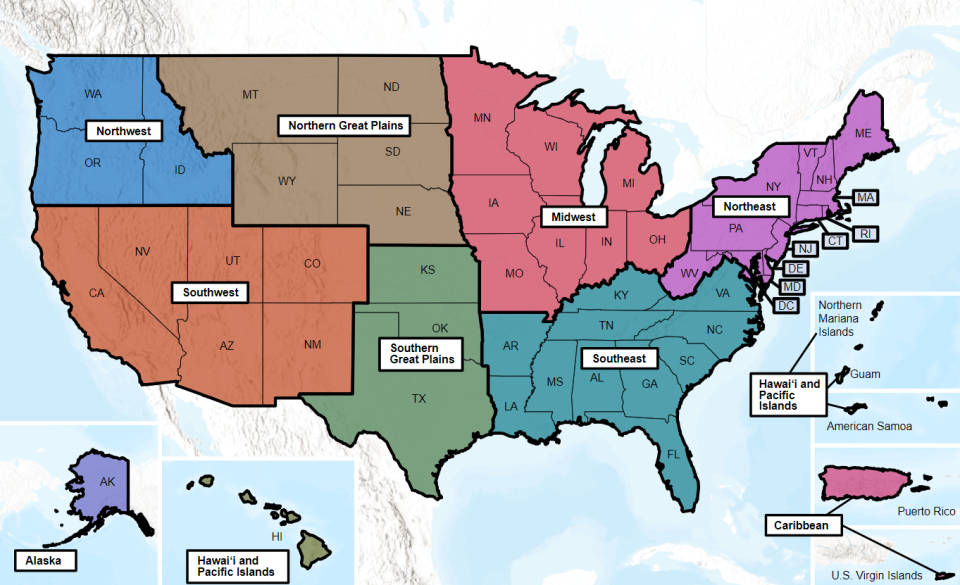Climate Change Connections: Arizona (Saguaro Cactus)
Climate change is impacting all regions and sectors of the United States. The State and Regional Climate Change Connections resource highlights climate change connections to culturally, ecologically, or economically important features of each state and territory. The content on this page provides an illustrative example. As climate change will affect each state and territory in diverse ways, this resource only describes a small portion of these risks. For more comprehensive information about regional climate impacts, please visit the Fifth National Climate Assessment and Climate Change Impacts by Sector.
On this page:
Introduction: The Saguaro Cactus Is a Keystone Species and an Icon of the Sonoran Desert
The saguaro cactus (Carnegiea gigantea) is the largest cactus species in the United States.1 It is an iconic symbol of the American Southwest and is critical to the Sonoran Desert ecosystem. Considered a keystone species (a species with far-reaching impacts on an ecosystem), the saguaro cactus provides food and shelter for many desert-dwelling creatures.2 The cactus is featured on the Arizona license plate and its blossom is the state flower.

Saguaros live exclusively in the Sonoran Desert, which spans northwest Mexico and parts of the southwestern United States, including southern Arizona. The saguaro is slow growing and can take up to 10 years to grow one inch.3 Once a saguaro reaches about 70 years of age, it can begin to sprout “arms.” Growing to the towering height of over 40 feet can take a saguaro nearly 200 years. Saguaros can store large amounts of water in their tissues to use during periods of drought. During dry periods, saguaros provide an important water source for animals such as bighorn sheep and jackrabbits.4 Once a saguaro reaches around 35 years of age, it can produce flowers, which can be pollinated by birds, insects, and bats.4
Saguaros hold particular importance for Indigenous Peoples of the Sonoran Desert, including the Tohono O’odham.5,6 The Tohono O’odham have harvested saguaro fruit for thousands of years for subsistence and cultural and religious practices. Saguaro ribs are used to create a harvesting tool to reach the saguaro fruits.6
Climate Impacts: Climate Change Will Bring Hotter Temperatures and Drier Soil to Arizona
Changing temperature and precipitation patterns are expected to affect saguaro cacti and their desert ecosystem. While mature saguaros are well adapted to desert heat and limited rainfall, climate change introduces extreme temperatures and changes in the frequency and intensity of rainfall that could threaten the species.7 Successful establishment of new saguaros can be hindered by drought and high temperatures.7 Studies have linked periods of higher precipitation and cooler temperatures with increased establishment of saguaro seedlings.7 Since the 1990s, coinciding with a period of high temperatures and prolonged drought, establishment of new saguaros has been low in Saguaro National Park.8
Since the beginning of the 20th century, temperatures in Arizona have increased by about 2.5°F.9 Temperatures are projected to further rise over the 21st century. Even relatively resilient mature cacti can be affected by unprecedented heat. The 2023 heat wave and drought in Phoenix drew media coverage for incidences of arms falling off the iconic cacti at the Desert Botanical Garden.10
As average temperatures have risen because of climate change, the Earth’s water cycle has sped up through an increase in the rate of evaporation from soil and transpiration from plants. An increase in evapotranspiration can result in drying over some land areas, leaving less moisture in the soil. Increasing temperatures and decreases in precipitation in already arid regions in the Southwest can create and amplify drought conditions. While yearly precipitation has been highly variable across Arizona since 2000, total precipitation from the summer monsoon season has been below average.9 Arizona has experienced long-term drought conditions for the past two decades, with varying degrees of severity from year to year in different parts of the state.9,11
Climate Impacts: Saguaros Face Threats from Invasive Species and Wildfires

Saguaros also face threats from invasive species and wildfires. Buffelgrass (Pennisetum ciliare) is an abundant invasive species that threatens ecosystems in the Sonoran Desert. Originally introduced to the Sonoran Desert in the 1930s to feed cattle and help control erosion, buffelgrass spread quickly across the region.12 Buffelgrass can outcompete native vegetation, such as juvenile saguaros, and accelerate how fire moves through the landscape by providing highly combustible fuel13 If buffelgrass is not controlled, it could outcompete several native species and promote regular, fast-moving wildfires that could damage the Sonoran Desert ecosystem.14
Climate change has led to an increase in wildfire season length, wildfire frequency, and burned area in the western United States.15 Factors like warming temperatures, drought, and drier soils and vegetation have contributed to longer wildfire seasons and more severe fires.15,16 Saguaros, and most plants native to the Sonoran Desert, are not well adapted to fire. Severe fires can kill saguaros, and those that survive fires have slower growth rates.17
Taking Action: Protecting a Unique Ecosystem
Addressing climate change requires reducing greenhouse gas emissions while preparing for and protecting against current and future climate impacts. Communities, public officials, and individuals in every part of the United States can continue to explore and implement climate adaptation and mitigation measures. In Arizona, park officials and partners are taking steps to protect saguaros and Sonoran ecosystems in a changing climate, including:
- Invasive species management. Controlling the spread of buffelgrass and reducing fire risk can help minimize threats to saguaro ecosystems. The U.S. National Park Service and the U.S. Forest Service already work together to control invasive species, including buffelgrass, in Saguaro National Park and surrounding areas.18 Saguaro National Park is also working with invasive species experts from nonprofits, such as the Tucson Audubon Society, to treat hard-to-reach areas of buffelgrass at high elevations.14
To learn more about climate change impacts in Arizona and the Southwest region, see Chapter 28 of the Fifth National Climate Assessment.
Related Resource
- EPA Climate Change Indicators: Drought and Temperature in the Southwest
- EPA Climate Change Indicators: Wildfires
- Arizona State Climate Summary 2022 (NOAA)
- Restoration Plan for Saguaro National Park (U.S. National Park Service)
- Climate Change (U.S. National Park Service)
References
1 Biel, A. W. (2009). Saguaro cactus: Sentinel of the Southwest. National Park Service. Retrieved January 17, 2024, from https://www.nps.gov/articles/saguaro-cactus-facts.htm
2 Southwest Biological Science Center. (2023). The iconic giant saguaro cactus in the Sonoran Desert. U.S. Geological Survey. Retrieved June 22, 2024, from https://www.usgs.gov/centers/southwest-biological-science-center/science/iconic-giant-saguaro-cactus-sonoran-desert
3 National Park Service. (2023). Saguaro cactus. Organ Pipe Cactus National Monument. Retrieved February 20, 2024, from https://www.nps.gov/orpi/learn/nature/saguaro-cactus.htm
4 National Park Service. (2024). The saguaro cactus. Saguaro National Park. Retrieved January 17, 2024, from https://www.nps.gov/sagu/learn/nature/saguaro.htm
5 Pater, M. J., & Siquieros, B. (2000). Saguaro cactus: Cultural significance and propagation techniques in the Sonoran Desert. Native Plants Journal, 1(2), 90–94. https://doi.org/10.3368/npj.1.2.90
6 Trust for Public Land. (n.d.). A Traditional Harvest at Saguaro National Park. Retrieved October 3, 2024 from https://www.tpl.org/blog/traditional-harvest-saguaro-national-park
7 Swann, D. E., Winkler, D. E., Conver, J. L., & Foley, T. (2021). Climate change and other factors influencing the saguaro cactus. Intermountain Park Science, National Park Service. Retrieved April 27, 2023, from https://www.nps.gov/articles/000/climate-change-and-other-factors-influencing-the-saguaro-cactus.htm
8 Conver, J. L., Foley, T., Winkler, D. E., & Swann, D. E. (2017). Demographic changes over >70 yr in a population of saguaro cacti (Carnegiea gigantea) in the northern Sonoran Desert. Journal of Arid Environments, 139, 41–48. https://doi.org/10.1016/j.jaridenv.2016.12.008
9 Frankson, R., Kunkel, K. E., Stevens, L. E., Easterling, D. R., Brown, T., Selover, N., & Saffell, E. (2022). Arizona state climate summary 2022 (NOAA Technical Report NESDIS 150-AZ). NOAA National Environmental Satellite, Data, and Information Service. https://statesummaries.ncics.org/chapter/az/
10 Associated Press. (2023, August 3). Phoenix’s extreme heat withers saguaros, trademark cactus of desert landscape. The Guardian. https://www.theguardian.com/us-news/2023/aug/03/phoenix-extreme-heat-withers-saguaros-cactus
11 NOAA National Integrated Drought Information System. (n.d.). Arizona. Retrieved December 6, 2023, from https://www.drought.gov/states/arizona
12 National Park Service. (n.d.). Buffelgrass. Saguaro National Park, Arizona. Retrieved December 8, 2023, from https://www.nps.gov/sagu/learn/nature/buffelgrass.htm
13 U.S. Geological Survey. (n.d.). What is buffelgrass? Retrieved April 27, 2023, from https://www.usgs.gov/faqs/what-buffelgrass
14 Grissom, P. (2022, October 5). Protecting and restoring the Sonoran Desert ecosystem in Saguaro National Park. U.S. Department of the Interior. https://www.doi.gov/wildlandfire/news/protecting-and-restoring-sonoran-desert-ecosystem-saguaro-national-park
15 Ostoja, S. M., Crimmins, A. R., Byron, R. G., East, A. E., Méndez, M., O’Neill, S. M., Peterson, D. L., Pierce, J. R., Raymond, C., Tripati, A., & Vaidyanathan, A. (2023). Focus on western wildfires. In A. R. Crimmins, C. W. Avery, D. R. Easterling, K. E. Kunkel, B. C. Stewart, & T. K. Maycock (Eds.), Fifth National Climate Assessment. U.S. Global Change Research Program. https://doi.org/10.7930/NCA5.2023.F2
16 Marvel, K., Su, W., Delgado, R., Aarons, S., Chatterjee, A., Garcia, M. E., Hausfather, Z., Hayhoe, K., Hence, D. A., Jewett, E. B., Robel, A., Singh, D., Tripati, A., & Vose, R. S. (2023). Ch. 2. Climate trends. In A. R. Crimmins, C. W. Avery, D. R. Easterling, K. E. Kunkel, B. C. Stewart, & T. K. Maycock (Eds.), Fifth National Climate Assessment. U.S. Global Change Research Program. https://doi.org/10.7930/NCA5.2023.CH2
17 Narog, M. G., Corcoran, B. M., & Wilson, R. C. (2013). Burned saguaro: Will they live or die? In G. J. Gottfried, P. F. Ffolliott, B. S. Gebow, L. G. Eskew, & L. C. Collins (Eds.), Merging science and management in a rapidly changing world: Biodiversity and management of the Madrean Archipelago III (pp. 351–356). https://www.fs.usda.gov/research/treesearch/44459
18 National Park Service. (2022). What actions are being taken. Saguaro National Park. Retrieved June 26, 2024, from https://www.nps.gov/sagu/learn/nature/what-actions-are-being-taken.htm

